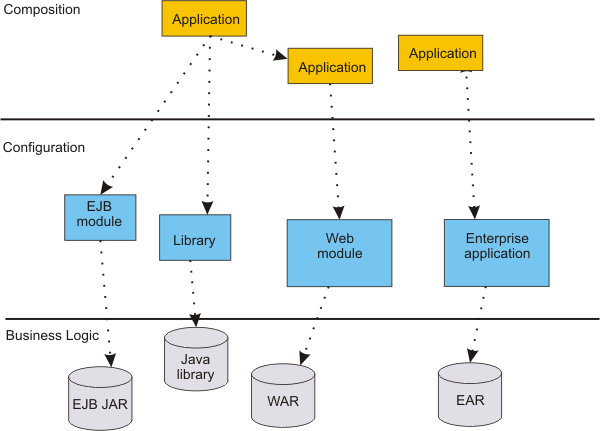Business-level applications
A business-level application is an administration model that provides the entire definition of an application as it makes sense to the business. A business-level application is a WebSphere® configuration artifact, similar to a server or cluster, that is stored in the product configuration repository.
Business-level application characteristics
A business-level application has the following characteristics:
The following diagram shows the composition model for business-level applications:

A business-level application does not introduce new programming, runtime, or packaging models:
Typically, you first create an empty business-level application and then add composition units to it. The business-level application name must be unique within a cell. The business level application itself has minimal configuration data associated with it, solely the list of composition units, but individual composition units might save application-specific configuration data.
A business-level application is defined in the product configuration repository under profile_root/config/cells/cell_name/blas/business_level_application_name/bver/BASE/bla.xml.
Comparisons to Java EE applications
Business-level applications can consist of or aggregate Java Platform, Enterprise Edition (Java EE) applications and modules with non-Java EE artifacts. The contents of Java EE applications integrate with business-level application concepts for deployment and management of applications. Existing Java EE application management APIs continue to work after you add Java EE application or modules to a business-level application. The business-level application management API accepts Java EE contents and configurations and delegates to existing Java EE management APIs. Control operations such as starting and stopping a Java EE composition unit are delegated to ApplicationManager MBean on application servers that start and stop Java EE applications.
| Java EE concept | Business-level application concept | Description |
|---|---|---|
| EAR or stand-alone module for deployment | Asset | Java EE application contents are assets. |
| Java EE application created at the end of application install | Composition unit | A Java EE application is in an enterprise archive (EAR) file. The product saves the EAR file in the product repository as a composition unit. |
| Java EE modules within the EAR file | Deployable units in the asset | Each module in the EAR file is a deployable unit that you can install on independent deployment targets. The EAR file is still managed as a single asset in its entirety. |
| Java EE application installation using the administrative console, programming, or wsadmin commands | Multiple
business-level application management
commands During Java EE application deployment, you can specify the name of the business-level application to include the Java EE application. If the business-level application name is not set, the product creates a default business-level application with the same name as the Java EE application name. The product adds a composition unit with the same name as the Java EE application name under the business-level application. You can deploy multiple Java EE applications under a single business-level application. |
You can make a Java EE application a business-level
application and add it to another business-level application:
Or, you can make a Java EE application an asset and add it to another business-level application:
|
| Uninstall Java EE application | Multiple business-level application management commands | You delete the Java EE application
composition
unit from the business-level application:
|
| Start the Java EE application. | Start the composition unit. | Starting a business-level application starts any Java EE application in it. |
| Stop the Java EE application. | Stop the composition unit. | Stopping a business-level application stops any Java EE application in it. |